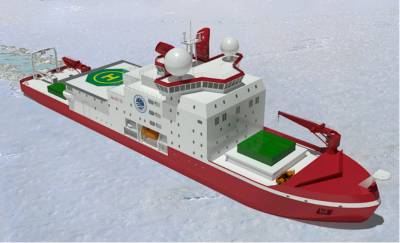Sonardyne Ranger 2 USBL Selected to Support Chinese Climate Change Research

Ocean science technology company, Sonardyne Asia Pte. Ltd., Singapore, has announced that its underwater acoustic positioning technology has been selected for China’s new polar research vessel currently under construction.
Commissioned by the Polar Research Institute of China, the 122 meter vessel will be equipped with a Ranger 2 USBL (Ultra-Short BaseLine) system to allow the position of scientific equipment deployed from the ship to be precisely tracked. This will include ROVs, AUVs and seafloor landers. Supplied through Sonardyne’s in-country agent, China ORE, Ranger 2 will also provide a position reference for the vessel’s Kongsberg dynamic positioning (DP) system, allowing the ship to remain in a specific location during science operations.
Entering service in 2018, the new vessel will conduct research into marine chemistry, ecology, geology, geophysics and sea ice dynamics, including determining how changes in Arctic sea ice is affecting China’s climate. Equipped to remain at sea for many months, it has a high strength hull to break through thick sea ice and provide Chinese scientists with unique access to study both polar regions.
Ranger 2 calculates the position of an underwater target by measuring the range and bearing from a vessel-mounted transceiver to a transponder attached to a vehicle or piece of equipment. Sonardyne’s exclusive wideband acoustic signal technology and 6G (sixth generation) hardware platform allows multiple targets to be simultaneously and precisely positioned in shallow and deep water.
The equipment being supplied to the Polar Research Institute of China includes Sonardyne’s popular Wideband Sub-Mini 6 (WSM 6), a small, lightweight USBL transponder that is easy to install and has a built-in depth sensor and rechargeable battery for added performance and convenience.
Commenting on the order, Anthony Gleeson, Vice President of Sonardyne in Singapore said, “Ranger 2 is a key enabler for research vessels and has the flexibility to meet the precise in-water and near-bottom sustained observation needs of science users working in nearshore, coastal and deep ocean waters.”
Qi Zhengyu, Director of China ORE added, “The Polar Research Institute of China joins a growing list of institutes who have recognized the valuable benefits of Sonardyne’s Ranger 2 acoustic technology. We looked forward to supporting them, the vessel’s shipyard and crew through the delivery, installation and commissioning phases of this prestigious contract.”
For more information on Ranger 2 USBL, please click here

